Written by Fabian Nicieza (#318- 324), Mark Gruenwald (#319-325), and Larry Hama (#326-333)
Pencilled by Paul Ryan (#318, 320, 322, 324, 326-332) , Tom Morgan (#318), Rik Levins (#319, 321, 323-325), James Fry (#319-320), Jim Reddington (#321-322), Mickey Ritter (#323), Brad Vancata (#323), and Herb Trimpe (#333)
Inked by Tom Palmer (#318, 320, 322, 324, 326-), Christopher Ivy (#319, 321, 323), Keith Williams (#319-320), Mickey Ritter (#321-323), Fred Fredericks (#324-325), Reggie Jones (#333), and Tom Morgan (#333)
After John Byrne left the Avengers titles, things started to flounder again, as the book did not seem to have any sort of clear direction. This set issues, which were published over the course of a year, thanks to an early experiment in double-shipping, were chosen for this review because my fifteen-year-old self stopped buying the title regularly with issue 333, and reading these books again, I could see why.
Fabian Nicieza dove in after John Byrne’s departure, finishing off his Nebula story arc, which featured Spider-Man, before writing ‘The Crossing Line.’ This six-part arc is basically an homage to The Hunt For Red October, and includes Alpha Flight and The Peoples’ Protectorate (a.k.a. The Soviet Super Soldiers) in a complicated story that touches on geo-politics, Altantean self-determination, and extra-dimensional exploration. These stories were backed up by a long-ish Mark Gruenwald-written story featuring the Avengers support crew, which finished in a whole-issue story. After that, Larry Hama came along, restructured the team’s charter, and debuted Rage, a total 90s character who showed up too early in that decade to be considered truly extreme. Rage was the final nail in the coffin for me.
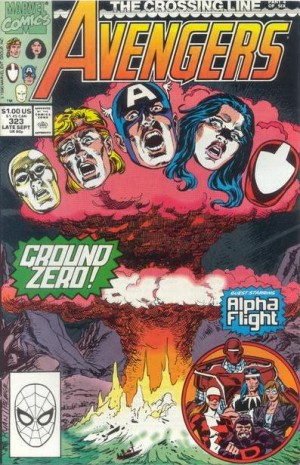 This set of issues can be recognized for the utter lack of character development, sub-plot, or consistency. Characters appear and disappear almost at random. The Black Widow is made a part of the active team, but goes issues without speaking or doing anything. The team gets a new charter from the UN (they found out that their US charter is revoked while they are in the middle of an adventure, with no explanation or reaction), which leads to a very complicated structure of ‘active’ Avengers, ‘reserve substitute’ Avengers, ‘probationary reserve substitute’ Avengers, and regular old reserve Avengers. The probationary members are Rage, because he’s angry and doesn’t want to be an Avenger anymore, and the Sandman, because he’s reforming, but is only around for like two issues, and no one talks about how or why he got invited. It feels like a lot of thought was put into this structure. The leader of the team is now referred to as the ‘Chair-being’, because ‘Chairman’ or ‘Chairperson’ is considered discriminatory. The only problem is that Hama doesn’t bother investing any real emotion into any character other than Rage, and that character is just embarrassing.
This set of issues can be recognized for the utter lack of character development, sub-plot, or consistency. Characters appear and disappear almost at random. The Black Widow is made a part of the active team, but goes issues without speaking or doing anything. The team gets a new charter from the UN (they found out that their US charter is revoked while they are in the middle of an adventure, with no explanation or reaction), which leads to a very complicated structure of ‘active’ Avengers, ‘reserve substitute’ Avengers, ‘probationary reserve substitute’ Avengers, and regular old reserve Avengers. The probationary members are Rage, because he’s angry and doesn’t want to be an Avenger anymore, and the Sandman, because he’s reforming, but is only around for like two issues, and no one talks about how or why he got invited. It feels like a lot of thought was put into this structure. The leader of the team is now referred to as the ‘Chair-being’, because ‘Chairman’ or ‘Chairperson’ is considered discriminatory. The only problem is that Hama doesn’t bother investing any real emotion into any character other than Rage, and that character is just embarrassing.
Let’s take a look at the main story events from this run:
- The Avengers and the Stranger defeat Nebula.
- Captain America awkwardly fires Spider-Man, who had just been made a member of the team an issue or two before.
- The Avengers, with Stingray in tow, try to find a stolen Soviet submarine, only to get into it with the People’s Protectorate.
- Those two teams have to team-up to fight off some angry Atlanteans (because apparently no one noticed that the stolen Soviet sub was drifting alongside an underwater civilization).
- When the sub crew goes to Newfoundland to effect repairs, Alpha Flight joins the two other hero teams in trying to stop the terrorist organization, actually called the Peace Corpse, from using the nuclear weapons on board.
- Somehow, two of the terrorists are joined into a weird amalgamated being who sets off the nuclear bombs, forcing Shaman to stick everything into his pouch.
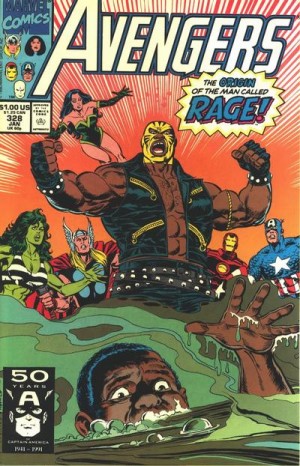 Various heroes, scattered throughout Shaman’s pouch, need to find each other and find their way out into the world again, without irradiating everything.
Various heroes, scattered throughout Shaman’s pouch, need to find each other and find their way out into the world again, without irradiating everything.- While the Avengers are in Canada, each member of their support team is confronted with a figure from their past, part of a scheme by Mother Night to control their minds so they can spy on the Avengers.
- During a party (this was a theme that year), the mind-controlled crew try to kill the Avengers.
- Rage, a large black man who goes shirtless under a leather vest and wears a yellow luchadore mask comes to the Avengers to complain about how they don’t have any ‘righteous’ black men on the team, because Black Panther is African and Falcon is a loser.
- The guy who stopped Chernobyl from melting down comes to New York for treatment, but goes nuts, and the Avengers have to try to stop him.
- Rage decides to destroy a condemned crack house which has a luxurious apartment in it where a gangster with a very prodigious vocabulary lives.
- The Avengers fight the Russian guy, with help from Rage, and they all have to go to another dimension (another theme that year) to take away his powers.
- In that other dimension, they fight a lot of monsterish creatures, who trick them into taking a little friend of theirs back to Earth.
- That little monster brings the others to Earth, and they team up with the gangsters that don’t like Rage, and take his grandmother hostage. She thinks they are devils from the Old Testament (seriously).
- Quasar starts wearing one of the worst costumes of the early 90s. It’s really terrible.
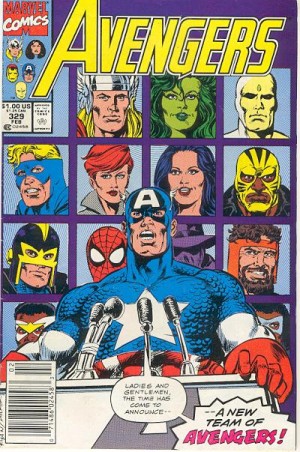 The Avengers announce their new UN charter, their complicated internal structure, and their new line-up. Nowhere in this issue is there mention of the West Coast team, which continued to operate under different rules.
The Avengers announce their new UN charter, their complicated internal structure, and their new line-up. Nowhere in this issue is there mention of the West Coast team, which continued to operate under different rules.- Spider-Man is one of these reserve substitutes, even though we saw him get fired before, and no explanation is given of how he made it back on the team.
- Some other creatures, called the Tetrarchs of Entropy, come to Earth angry that the other monsters are out of the dimension where they imprisoned them. They imprison the Avengers, who get free.
- The Avengers and the Tetrarchs go to stop the monsters, and rescue Rage’s granny.
- The Avengers have a party to show off their new headquarters. Rage brings cupcakes from his granny (seriously).
- The Avengers suspect that Doctor Doom has crashed their party, so they let Captain America, Vision, and Sandman investigate, without alarming their guests, who represent some of the most powerful people in the Marvel Universe, because they wouldn’t want to take them away from cocktail franks and Rage’s granny’s cupcakes.
- Eventually everyone figures out that Doctor Doom is there, because he takes over the whole building, and threatens to blow it and himself up if the Avengers don’t help him free his mother from Hell, using whatever trick they used to free the monsters from before. The Avengers explain that they can only do that with Thor, and they don’t know where he is right then, so they can’t help Doom. Doom leaves.
- At this point, I also left, dropping the title.
Like I said, this run was a mess. I think I would have weathered the stupid plots, but the lack of character development (other than Rage) gave me no reason to stick around. And really, Rage himself is a big problem. I can appreciate that Hama was trying to address the consistent lack of diversity on the team, but Rage is just too clichéd and silly a character to make it work. Had Hama played up the fact that he was just a fourteen year old in an adult body, like what Geoff Johns did with Captain Marvel in JSA, he might have gotten somewhere, but instead, I found the character exhausting, and not Avengers material.
It’s 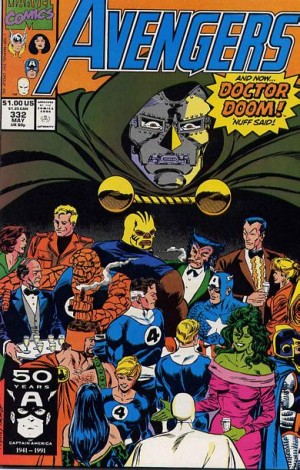 hard to say who was on the team during this era, as characters randomly appeared and disappeared a lot, and often just stood around in the background without doing anything. Also, there were a lot of parties where former Avengers were invited. From what I can guess, the line-up included:
hard to say who was on the team during this era, as characters randomly appeared and disappeared a lot, and often just stood around in the background without doing anything. Also, there were a lot of parties where former Avengers were invited. From what I can guess, the line-up included:
 hard to say who was on the team during this era, as characters randomly appeared and disappeared a lot, and often just stood around in the background without doing anything. Also, there were a lot of parties where former Avengers were invited. From what I can guess, the line-up included:
hard to say who was on the team during this era, as characters randomly appeared and disappeared a lot, and often just stood around in the background without doing anything. Also, there were a lot of parties where former Avengers were invited. From what I can guess, the line-up included:- Captain America
- Vision
- Sersi
- She-Hulk
- Thor
- Iron Man
- Spider-Man (briefly)
- Quasar
- Stingray (as an associate)
- Rage (in a probationary role)
- Sandman (in a probationary role)
- Black Widow (in a ‘stand around and don’t even talk’ role)
Reading through these old issues has been fun, but really, everything after Roger Stern left in the upper 200s was moving along a downward spiral of mediocrity. The art remained remarkably consistent, with Paul Ryan and inker extraordinaire Tom Palmer putting in some very nice work, but there were a lot more guest artists that muddied thing up.
After dropping the title, I did keep picking up some random issues, mostly because of tie-ins or guest stars, so for my next Retro-Review, I’ll look at the few issues I have that took us up to Heroes Reborn. I’m pretty sure I skipped the worst of it though, as I’ve never read a chapter of The Crossing.
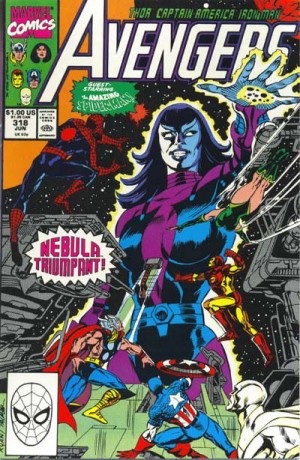

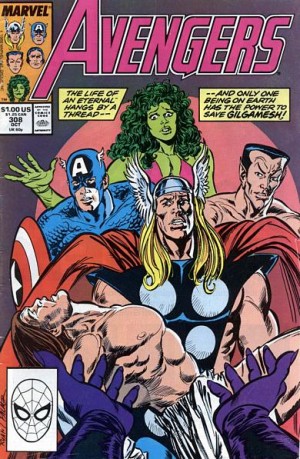
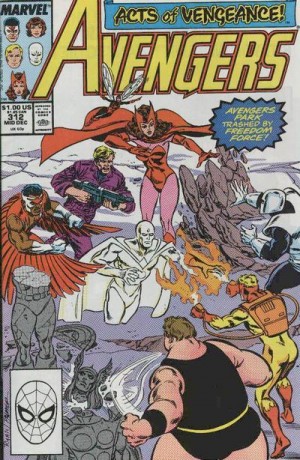
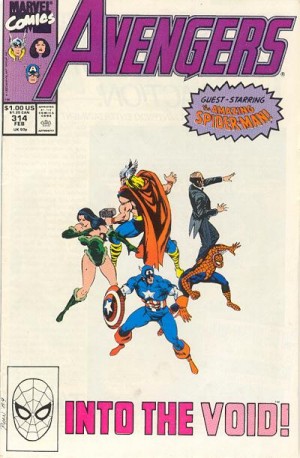
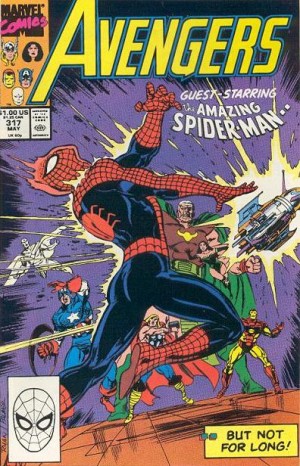


 deal with the Super-Adaptoid's plans to take over the Cosmic Cube, after recruiting a number of robots to aid him, including Machine Man.
deal with the Super-Adaptoid's plans to take over the Cosmic Cube, after recruiting a number of robots to aid him, including Machine Man.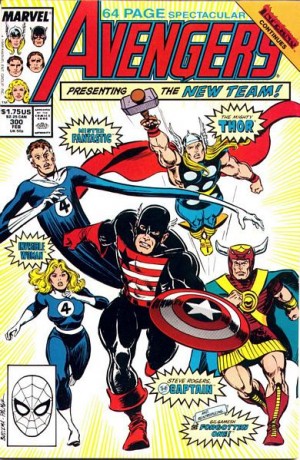 fighting these ridiculous villains, Gilgamesh, the Forgotten Eternal shows up to help fight, just cause.
fighting these ridiculous villains, Gilgamesh, the Forgotten Eternal shows up to help fight, just cause.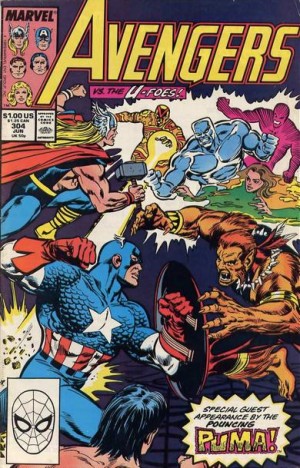 line-ups were exactly classic.
line-ups were exactly classic.